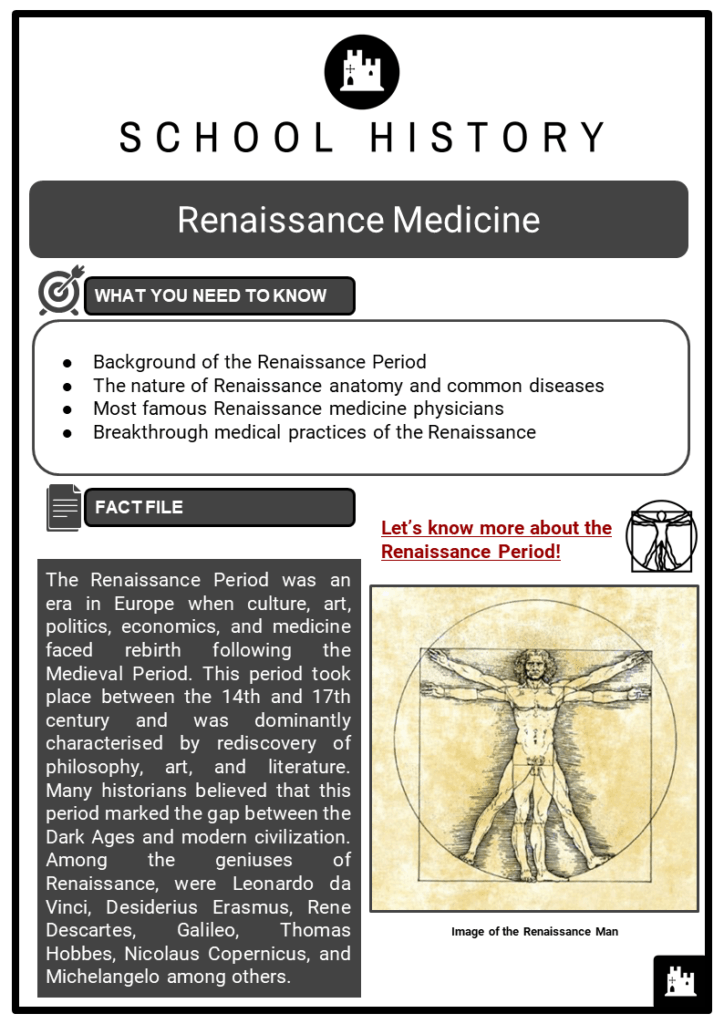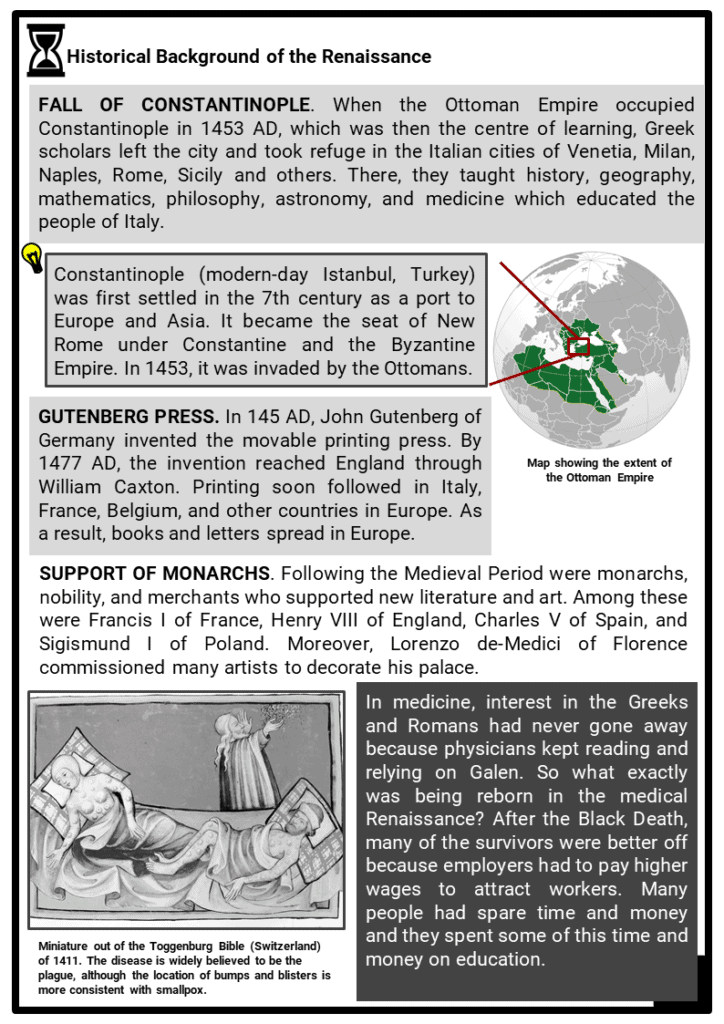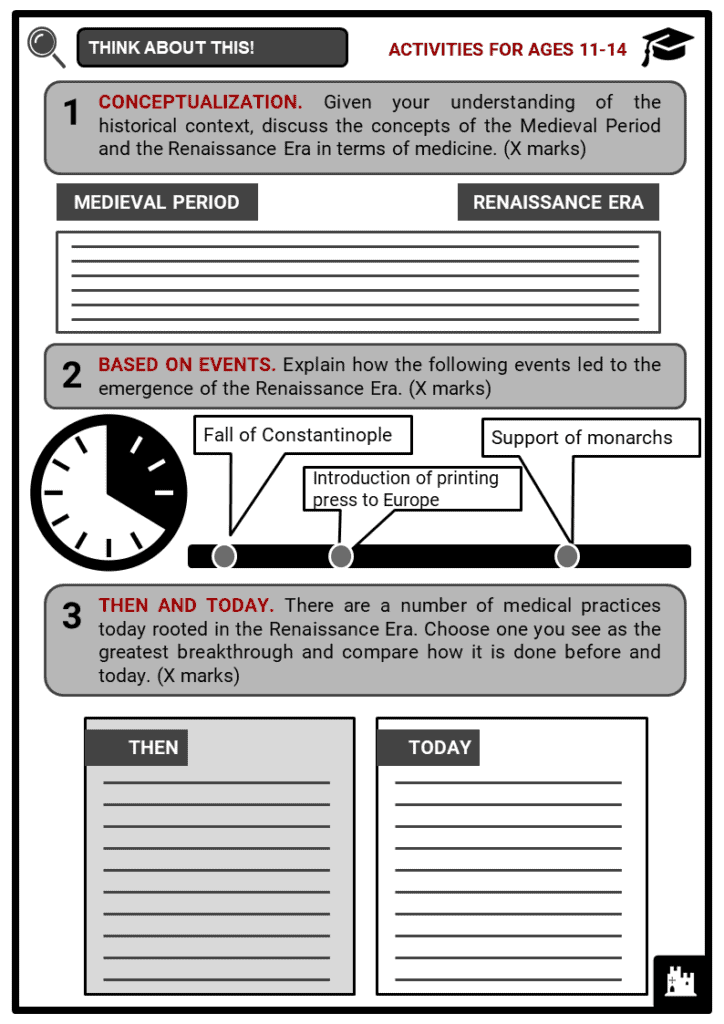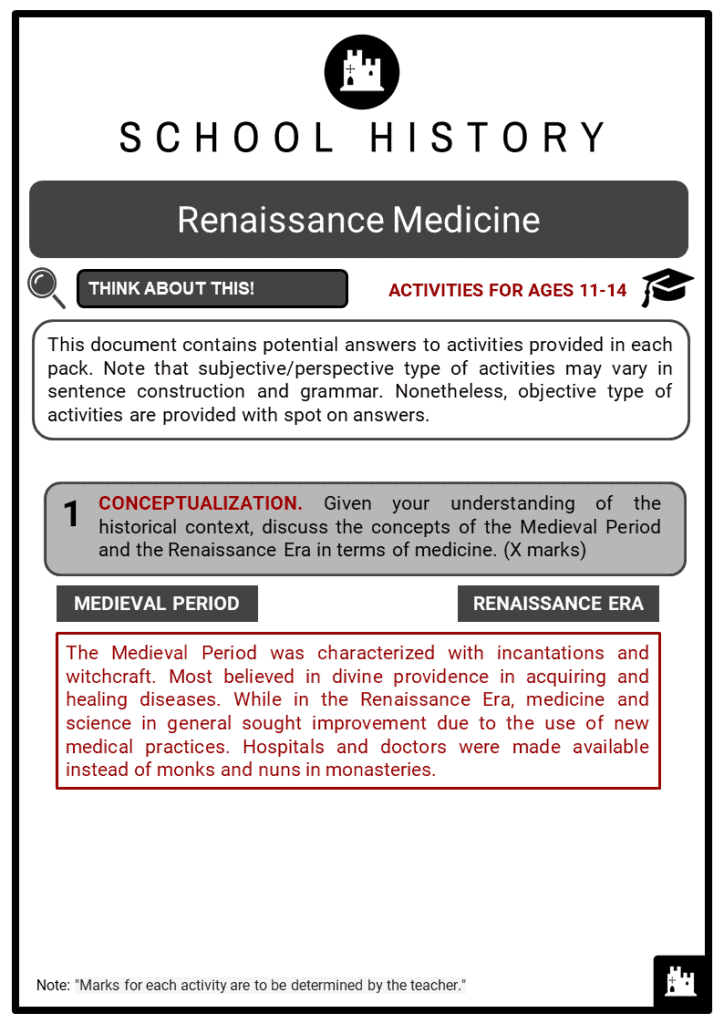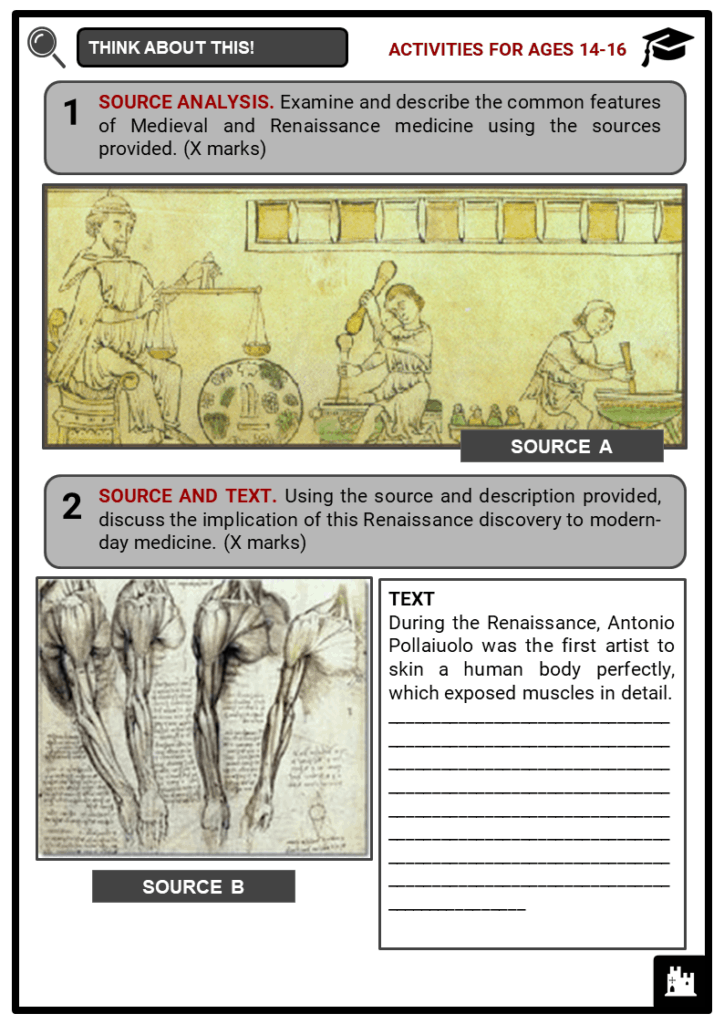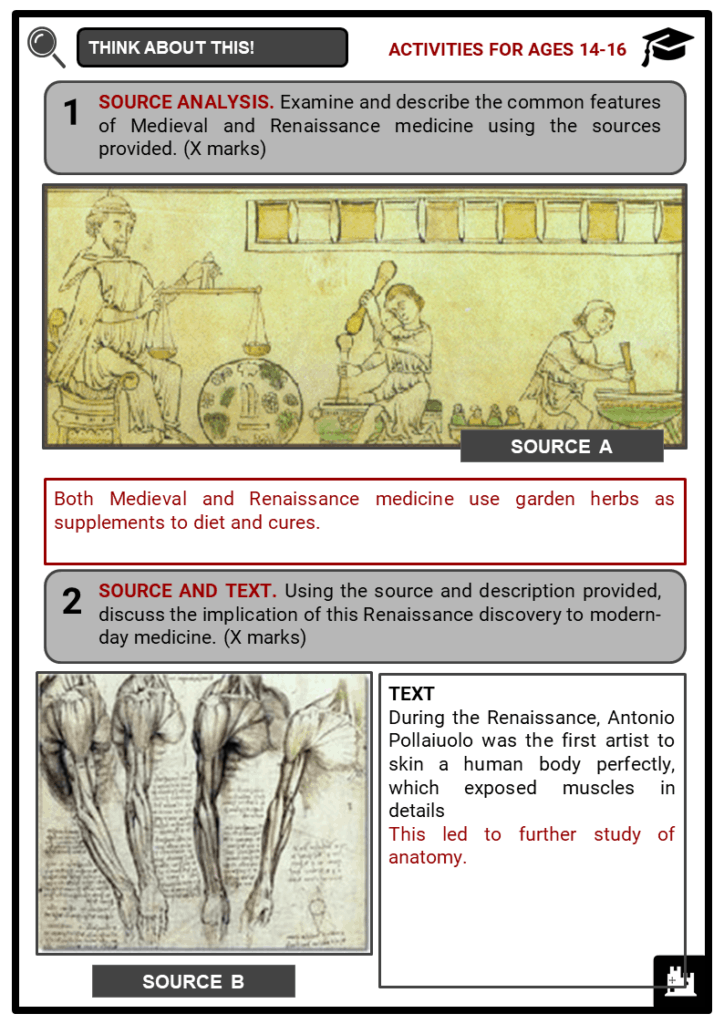Download Renaissance Medicine Worksheets
Do you want to save dozens of hours in time? Get your evenings and weekends back? Be able to teach Renaissance Medicine to your students?
Our worksheet bundle includes a fact file and printable worksheets and student activities. Perfect for both the classroom and homeschooling!
Table of Contents
Add a header to begin generating the table of contents
Summary
- Background of the Renaissance Period
- The nature of Renaissance anatomy and common diseases
- Most famous Renaissance medicine physicians
- Breakthrough medical practices of the Renaissance
Key Facts And Information
Let’s know more about the Renaissance Period!
- The Renaissance Period was an era in Europe when culture, art, politics, economics, and medicine faced rebirth following the Medieval Period. This period took place between the 14th and 17th century and was dominantly characterised by rediscovery of philosophy, art, and literature. Many historians believed that this period marked the gap between the Dark Ages and modern civilization. Among the geniuses of Renaissance, were Leonardo da Vinci, Desiderius Erasmus, Rene Descartes, Galileo, Thomas Hobbes, Nicolaus Copernicus, and Michelangelo among others.
Historical Background of the Renaissance
- FALL OF CONSTANTINOPLE. When the Ottoman Empire occupied Constantinople in 1453 AD, which was then the centre of learning, Greek scholars left the city and took refuge in the Italian cities of Venetia, Milan, Naples, Rome, Sicily and others. There, they taught history, geography, mathematics, philosophy, astronomy, and medicine which educated the people of Italy.
- Constantinople (modern-day Istanbul, Turkey) was first settled in the 7th century as a port to Europe and Asia. It became the seat of New Rome under Constantine and the Byzantine Empire. In 1453, it was invaded by the Ottomans.
- GUTENBERG PRESS. In 145 AD, John Gutenberg of Germany invented the movable printing press. By 1477 AD, the invention reached England through William Caxton. Printing soon followed in Italy, France, Belgium, and other countries in Europe. As a result, books and letters spread in Europe.
- SUPPORT OF MONARCHS. Following the Medieval Period were monarchs, nobility, and merchants who supported new literature and art. Among these were Francis I of France, Henry VIII of England, Charles V of Spain, and Sigismund I of Poland. Moreover, Lorenzo de-Medici of Florence commissioned many artists to decorate his palace.
- In medicine, interest in the Greeks and Romans had never gone away because physicians kept reading and relying on Galen. So what exactly was being reborn in the medical Renaissance? After the Black Death, many of the survivors were better off because employers had to pay higher wages to attract workers. Many people had spare time and money and they spent some of this time and money on education.
- Many called the Black Death the Bubonic Plague, which refers to the telltale buboes. These are painfully swollen lymph nodes, usually seen around the neck or armpit. Along with this are the early symptoms, including vomiting, nausea, and fever.
- In the Middle Ages, people respected traditional ideas and simply copied Greek knowledge and ideas. They did not challenge them. But in the Renaissance, people realized that the Greeks loved inquiry – asking questions, challenging old ideas (like the gods causing disease) and suggesting new ones (the Theory of the Four Humours).
Renaissance Anatomy
- The main factor that contributed to Renaissance medicine was increased anatomical knowledge. Societies eased the cultural and legal restrictions that had been put on dissecting cadavers. This allowed physicians to carry out many anatomical studies, making a lot of new discoveries about the human anatomy.
- The Middle Ages
- Run by feudal lords, small territories in the Middle Ages were populated by rural servitude.
- There were no public health services and communication was poorly utilized.
- As a result, many believed in superstitions. They could not read or write. Monks were the only people who were educated and had the chance to teach philosophy and science.
- People in Medieval Europe were rarely checked by medical practitioners; instead local wise woman or witches provided herbs or incantations. When the Roman Catholic Church dominated the era, spells replaced prayers to saints. Moreover, people began to practice penance and pilgrimages for repentance for sins.
- With the emergence of monks as healers, monasteries became the home of the sick and dying.
- Knowledge from the Middle East
- Another important aspect of Renaissance medicine was the transmission of medical knowledge from the Middle East. Scholars from the Islamic world had made some important advancements in disease and injury treatment. Some of this knowledge was transmitted to Europe during the collapse of the Islamic dominion when some Muslim scholars fled to Europe.
- The Crusaders were impressed by the advanced medical techniques that were being used by Islamic doctors to treat diseases. When the Crusaders returned to Europe, they brought this knowledge back home. Physicians in Europe were thus able to scrutinise how the body worked and refine their knowledge of human anatomy.
- During the Medieval period, medicine was part of the Islamic culture. Mosques were often built long with hospitals. By 900 CE, many communities in the Muslim world developed medical practices using scientific elements as contrasted to earlier beliefs on divine providence in treating illnesses. Among the most popular Muslim doctor known by the Europeans was Ibn Sina, commonly referred to as Avicenna. Born as a Persian, Ibn Sina wrote about 240 books and articles on medicine, including the Book of Healing and The Canon of Medicine. These books were used in the mid 16th century in universities in Belgium and France.
- Diseases and Epidemics
- During the Renaissance period, common diseases included leprosy, smallpox, and the dangerous and dreaded Black Death. Before explorers from Spain sailed to the Americas, diseases such as measles, smallpox, and the deadly influenza were unheard of there. As a result, the American Natives were not immune to such diseases, and they were deadly to them.
Famous Renaissance Physicians
- Girolamo Fracastoro
- He was born in Italy and lived from 1478 to 1553. He was the first doctor to suggest that human diseases may be caused by pathogens. He further stated that these pathogens came from outside the body and could be passed from one human to another through direct and indirect contact.
- Andreas Vesalius
- He was a Flemish physician and anatomist who lived from 1514 to 1564. He wrote the book “De Humani Corporis Fabrica.” This became a very important book written on human anatomy. He dissected corpses and examined them, after which he detailed human anatomy.
- William Harvey
- Born in 1578, William Harvey was a doctor in England. He became the first doctor to ever describe properly how the human circulatory system worked. He also described the blood properties and how the heart worked to circulate the blood around the body. He died in 1567.
- Paracelsus
- He was a German doctor who lived from 1493 to 1541. He was also a scholar and an occultist. He was the first person to demonstrate that chemicals and minerals could be safely used in the human body. According to him, diseases and health depended on how a person’s body was in harmony with nature. He also proposed that certain mineral and chemical balances were required for the body to be healthy.
- Leonardo da Vinci
- He was born in Italy, lived from 1452 to 1519, and was skilled in many fields, including anatomy. He dissected human corpses to study tendons, bones, and muscles. He was permitted to dissect and study human corpses in some hospitals and created a book with over 100 pages that had notes and illustrations about the anatomy of the human body. He also studied the human skeletal structure and how the muscles made the bones move. He was one of the pioneers in the study of biomechanics.
- Ambroise Pare’
- He was a doctor from France who lived from 1510 to 1590. He was the father of modern forensic pathology and surgery. He served as the royal surgeon in the Kingdom of France and was an expert in treating soldiers who were wounded on the battlefield. He made several instruments that were used for surgery.
Renaissance Medical Practices
- AUTOPSY was first introduced by the Greeks in Europe, but was immediately halted with the rise of the Church. Leonardo da Vinci had several accounts on dissection of the human body, while Giovanni Battista Morgagni led autopsy in science form.
- Today, autopsy is a general procedure of finding out the cause of death.
- TREPANATION was a surgical procedure in which a hole is drilled into the skull to treat intracranial ailments. The screw-like saw and holder were believed to treat seizure and mental disorders.
- BLOODLETTING using leeches became a prominent practice in the Renaissance era until the 19th century. Based on the theory of ‘humors,’ blood’s imbalance was pointed out as the cause of headache, fever, apoplexy, and others. As a cure, blood was withdrawn until the patient began to swoon.
- Prior to the Renaissance, ancient Egyptians developed the theory of humorism, which Greek scholars carried on to the Roman, the Muslim, and European medical practitioners.
- According to the theory, a human had four different bodily fluids that influenced its health. Imbalance would cause a person to become sick.
- Medical practitioners would then recommend bloodletting using leeches and consuming special diet and medication, such as herb gardens.
- Accounts showed that C-SECTION was used in the Renaissance era as an extreme and rare approach of child delivery. During the Medieval times, high mortality rates of C-section made it unpopular. It was only in the 20th century when this method improved and was accepted worldwide.
- Other practices included, maggot therapy, cauterization, tracheostomy, enema, catheterization, fecal transplant, and cataract surgery.
Nature of Hospitals from the Middle Ages to the 18th Century
- Medieval Hospitals - Monasteries were run by nuns and monks who believed it was their Christian duty to care for the sick.
- As such, health and religion were closely connected.
- Wealthy Christians financed monasteries, which had plumbing, toilets, and clean water.
- However, these hospitals refused to admit lepers, lunatics, and people with falling sickness or contagious diseases. No pregnant women or women with breastfeeding infants. No intolerable people even if they’re poor or infirm. If any one of these are admitted by mistake, they’re to be expelled immediately.
- Things only really began to change in the 18th century when new hospitals were built with wards for different diseases.
- Pharmacies emerged to give the poor free medicine. Scientific approaches to surgery based on dissection meant more sophisticated procedures and techniques. The microscope (16th century) and discovery of bacteria (17th century) later led to Edward Jenner discovering a smallpox vaccine in 1796.

